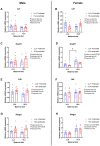Maternal Diet High in Linoleic Acid Alters Offspring Lipids and Hepatic Regulators of Lipid Metabolism in an Adolescent Rat Model
- PMID: 38256199
- PMCID: PMC10816089
- DOI: 10.3390/ijms25021129
Maternal Diet High in Linoleic Acid Alters Offspring Lipids and Hepatic Regulators of Lipid Metabolism in an Adolescent Rat Model
Abstract
Linoleic acid (LA), an n-6 polyunsaturated fatty acid (PUFA), is essential for fetal growth and development. A maternal high LA (HLA) diet alters cardiovascular development in adolescent rats and hepatic function in adult rats in a sex-specific manner. We investigated the effects of an HLA diet on adolescent offspring hepatic lipids and hepatic lipid metabolism gene expression, and the ability of the postnatal diet to alter these effects. Female Wistar Kyoto rats were fed low LA (LLA; 1.44% energy from LA) or high LA (HLA; 6.21% energy from LA) diets during pregnancy and gestation/lactation. Offspring, weaned at postnatal day (PN) 25, were fed LLA or HLA and euthanised at PN40 (n = 6-8). Maternal HLA increased circulating uric acid, decreased hepatic cholesterol and increased hepatic Pparg in males, whereas only hepatic Srebf1 and Hmgcr increased in females. Postnatal (post-weaning) HLA decreased liver weight (% body weight) and increased hepatic Hmgcr in males, and decreased hepatic triglycerides in females. Maternal and postnatal HLA had an interaction effect on Lpl, Cpt1a and Pparg in females. These findings suggest that an HLA diet both during and after pregnancy should be avoided to improve offspring disease risk.
Keywords: linoleic acid; maternal; offspring; sex-specific liver.
Conflict of interest statement
The authors declare no conflicts of interest.
Figures



Similar articles
-
Sex-Specific Changes to Brain Fatty Acids, Plasmalogen, and Plasma Endocannabinoids in Offspring Exposed to Maternal and Postnatal High-Linoleic-Acid Diets.Int J Mol Sci. 2024 Jul 19;25(14):7911. doi: 10.3390/ijms25147911. Int J Mol Sci. 2024. PMID: 39063152 Free PMC article.
-
Maternal and Postnatal High Linoleic Acid Diet Impacts Lipid Metabolism in Adult Rat Offspring in a Sex-Specific Manner.Int J Mol Sci. 2021 Mar 14;22(6):2946. doi: 10.3390/ijms22062946. Int J Mol Sci. 2021. PMID: 33799409 Free PMC article.
-
Maternal diet high in linoleic acid alters offspring fatty acids and cardiovascular function in a rat model.Br J Nutr. 2022 Feb 28;127(4):540-553. doi: 10.1017/S0007114521001276. Epub 2021 Apr 16. Br J Nutr. 2022. PMID: 33858529
-
Elevated maternal linoleic acid reduces circulating leptin concentrations, cholesterol levels and male fetal survival in a rat model.J Physiol. 2019 Jul;597(13):3349-3361. doi: 10.1113/JP277583. Epub 2019 Jun 2. J Physiol. 2019. PMID: 31124126
-
Sex-Specific Differences in Lysine, 3-Hydroxybutyric Acid and Acetic Acid in Offspring Exposed to Maternal and Postnatal High Linoleic Acid Diet, Independent of Diet.Int J Mol Sci. 2021 Sep 23;22(19):10223. doi: 10.3390/ijms221910223. Int J Mol Sci. 2021. PMID: 34638563 Free PMC article.
Cited by
-
Maternal Diet High in Linoleic Acid Alters Renal Branching Morphogenesis and mTOR/AKT Signalling Genes in Rat Fetal Kidneys.Int J Mol Sci. 2024 Apr 25;25(9):4688. doi: 10.3390/ijms25094688. Int J Mol Sci. 2024. PMID: 38731907 Free PMC article.
-
The Many Facets of PPAR-γ Agonism in Obesity and Associated Comorbidities: Benefits, Risks, Challenges, and Future Directions.Curr Obes Rep. 2025 Feb 12;14(1):19. doi: 10.1007/s13679-025-00612-4. Curr Obes Rep. 2025. PMID: 39934485 Review.
-
Sex-Specific Changes to Brain Fatty Acids, Plasmalogen, and Plasma Endocannabinoids in Offspring Exposed to Maternal and Postnatal High-Linoleic-Acid Diets.Int J Mol Sci. 2024 Jul 19;25(14):7911. doi: 10.3390/ijms25147911. Int J Mol Sci. 2024. PMID: 39063152 Free PMC article.
-
Maternal Long-Chain Polyunsaturated Fatty Acids Status in Pregnancy and Newborn Body Composition.Nutrients. 2024 Dec 27;17(1):66. doi: 10.3390/nu17010066. Nutrients. 2024. PMID: 39796500 Free PMC article.
References
-
- Bariani M.V., Correa F., Domínguez Rubio A.P., Marvaldi C., Schander J.A., Beltrame J.S., Cella M., Silberman D.M., Aisemberg J., Franchi A.M. Maternal obesogenic diet combined with postnatal exposure to high-fat diet induces metabolic alterations in offspring. J. Cell. Physiol. 2020;235:8260–8269. doi: 10.1002/jcp.29482. - DOI - PubMed
MeSH terms
Substances
Grants and funding
LinkOut - more resources
Full Text Sources
Research Materials

